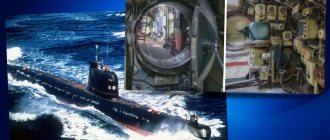Why are films about submariners so popular?
A movie lover who enjoys intense psychological thrillers will never pass by any film about submariners indifferently. Why? Yes, because the confrontation between submarines and their surface (often) destroyers can be so psychologically intense that at the time you get on your nerves and eat buckets of popcorn.
Recognition of noise by acoustics using sonars, echo sounders, etc., the physical impossibility of visually monitoring what is happening overboard and the every second possibility of flooding during military clashes, all this keeps in extreme tension and makes the viewer literally gnash his teeth. So, for those who value tooth enamel, it is best to insert a mouth guard between your jaws before watching such films.
By the way, there are no documentaries about submarines on our list. We, of course, understand that films like “Kursk: Submarine in Troubled Waters” (2004) and others are very interesting and informative, but we will somehow devote our top to documentaries. Films from other genres will be covered here to the extent that their rating allows them to enter the top 30.
So, let's go, and let's start with the most frequently watched film with a very informative and unambiguous title...
A documentary about the “hunt” for a Russian submarine that allegedly collided with the Royal Navy frigate HMS Northumberland in 2022 has appeared on the Internet.
Let us remind you that the incident that took place two years ago became known only recently. The fact of a collision with a Russian submarine was confirmed by the British Ministry of Defense, although after a long time.
The history of the emergency is as follows. As reported by the BBC News portal, the British ship HMS Northumberland was patrolling the waters of the North Atlantic. A Russian submarine was spotted 300 kilometers off the coast of Scotland. According to the British military, their frigate began to monitor the submarine, scanning the underwater space. As a result, the Russian submarine allegedly rammed the ship's sonar.
According to media reports, the “hunt” for the Russian submarine lasted 48 hours. The Merlin deck helicopter was used in the search.
An amazing coincidence: in addition to the crew, a film crew from the UK’s Fifth TV Channel happened to be on board the British ship. Journalists, jubilant, captured the historic incident on camera. This unique material formed the basis of a documentary film from the “Life at Sea” series.
The appearance of this film was supposed to be a sensation. Participants in the “hunt” for the evil Russian submarine (Northumberland crew members and Merlin pilots) speak with delight of their heroic mission, of long and grueling hours of search, which were suddenly crowned with success. And how!
“It is very difficult to detect a Russian submarine on sonar, but almost impossible to observe it on the surface,” states the voiceover.
However, oddly enough, this is exactly the miracle that happened to British sailors and Channel 5 journalists. Television crews managed to capture an unheard-of spectacle - the periscope of a Russian submarine “peeping out” from the ocean depths.
It is worth noting that the documentary about the hunt for a malicious enemy submarine turned out to be very emotional. After an intense 48 hours of searching, the “hunters” smile happily. They managed to detect the enemy and secure “Great Britain’s vital underwater communications” from Russian sabotage.
To increase the emotional level of the material, journalists conducted several personal interviews with participants in the “hunt.” Thus, one of the Merlin pilots shares the happy news about his wife’s pregnancy, who is looking forward to the hero’s return home.
However, there is a fly in the ointment in this barrel of cinematic honey. It has not yet been officially established which Russian submarine was pursued in the vastness of the Atlantic two years ago by the crew of the frigate Northumberland and journalists from Channel Five. However, Internet users, having taken a closer look at the screenshots of the videos depicting elements of the submarine shown in the film, came to an unexpected conclusion. PolitRussia what kind of object observant viewers saw in the documentary about the hunt for a Russian submarine .
Submarine (1981) 8.05
Predictably, the film about a submarine with the highest rating belongs to the Great Patriotic War. But it is very strange that in this film we will have to sympathize not with Soviet submariners, and not with submariners of the Allied forces, but, precisely, with the Nazis.
Yes, indeed, the film was made by the Germans about German submariners during World War II. And it is famous not only for the excellent work done by Wolfgang Petersen, but also for the excellent soundtrack, the main theme of which is the composition of Klaus Doldinger “Auslaufen”. Let's listen and at the same time watch a unique trailer.
Now let’s look at the “Das Boot” video, filmed for the famous version, remade by the German group “U-96” into techno in 2000. This version has sold over 1 million copies worldwide.
Well, now that we’ve listened to enough music and seen enough trailers, let’s talk about the film itself.
It is noteworthy that in its original version, in 1981, the film was released with a running time of 2 hours and 30 minutes. A 3 hour 30 minute version was later released. The final “full” version became the final version, which turned out to be a mini-series, divided into 3 parts, with a total duration of almost 5 hours (293 minutes).
The film tells about the difficult fate of the crew of the U-96 submarine, which had the difficult task of sinking British ships in the stormy waters of the Atlantic. The crew fought heroically, their submarine managed to lie at the bottom, but, nevertheless, after heavy repairs, it surfaced so that, having arrived at its home point, in the port of La Rochelle occupied by German troops...
In general, what can I say. See for yourself. The film is 100% worth watching.
Submarine
Das Boot
- Germany, 1981.
- War drama, thriller.
- Duration: 150 minutes.
- IMDb: 8.3.
Autumn 1941. The German submarine U-96 is preparing to sail to the sites of fierce battles of World War II. At first everything goes according to plan, but then the submarine accidentally collides with a mine.
Wolfgang Petersen treated the reconstruction of historical reality very conscientiously. The director showed the everyday life of submariners so accurately that even real military personnel praise the film for its authenticity. Not to mention how frightening a closed space looks, in which the proximity of death is constantly felt.
The Abyss (1989) 7.86
We thought for a long time whether to include this masterpiece by James Cameron in our top best films about submariners, and finally decided that the film, after all, fits our theme.
Although there are no submarines as such, with the exception of the one that sank at the very beginning, and because of which all the fuss later turned out, almost the entire film was shot under water, and hard-working researchers working on a deep-sea platform , in fact, are submariners. They work here under great pressure, in special suits, using special submersibles, so who are they, if not the very best “submariners”?
In general, something is hidden in the sunken submarine that the warriors need to destroy at all costs, so that this something does not fall into the clutches of potential enemies, for example, the same Russians.
A team of Navy SEALs, led by Lieutenant Coffey, played superbly by Michael Biehn, descends on a deep-sea station. The military's task is to blow up the boat with a nuclear warhead. But the company of researchers clearly disagrees with this turn.
There are a lot of wonderful actors in the film, all of whom, as one, played simply wonderful. Anyone who has not yet watched this masterpiece is certainly missing out on a lot.
The submarine "Magadan" armed with "Calibers" was shown from the inside for the first time
The equipment, which amazes the imagination, entered service with the Russian army. Today is the single day for acceptance of government orders by the Ministry of Defense. Unique engineering solutions will protect our borders on land, in the sky and under water. Some developments are so secret that you can’t even talk about them. But Izvestia correspondent Ivan Litomin still managed to lift the veil of military secrecy.
These are truly unique shots: every movement of our film crew is monitored by the State Secrets Protection Service, and filming can only be done from certain angles. We are going down to the new diesel submarine Magadan.
“There is a first one... Open the valve... There is a sixth one...”
On board are eight Kalibr cruise missiles, the latest generation of hydroacoustics and navigation, maximum autonomy, and the latest enemy detection systems. Next to modern computers is located equipment that has been proven for decades.
“Hold, prepare the periscope for lifting,” says the crew.
To monitor the external situation here on the submarine, a good old periscope is used, which is brought directly to the command post.
The submarine will enter service with the Pacific Fleet in the next few weeks. Magadan became the third submarine in project 636.3. In 2022, the Petropavlovsk-Kamchatsky was delivered, in 2020 there was the Volkhov, and now the military is accepting the Magadan. It is worth noting that by 2024 they plan to accept three more submarines in this project.
The Magadan submarine was laid down on November 1, 2022 and launched on March 26, 2022 in a state of high readiness. Project 636.3 submarines are among the quietest in the world. The length of the submarines reaches 74 meters, the maximum displacement is over 3,900 tons, the working diving depth is 240 meters, and the maximum diving depth is 300 meters. The range is 7,500 miles.
Defense Minister Sergei Shoigu was also reported from the Rostov region, where new helicopters had already arrived the day before.
New Ka-52 helicopters perform their first flights. So far, the Alligators have the simplest task - to take off, make several circles around the airfield and land. On this day, the updated version of the Mi-28 is also delivered. The Night Hunter has been improved: the volume of fuel tanks has been increased and a system for interacting with drones has been added. The helicopter has become more manageable.
“The shaking of the helicopter has decreased. There is no shaking in almost the entire speed range. It’s much easier to aim, collect aiming marks, and so on,” says Sergei Kotov, senior test pilot of the military representative office of the Russian Defense Ministry.
A brand new “drying” aircraft, a modernized version of the Su-30SM2, also takes off into the air. This fighter has no analogues in the world, and now it has become even faster and more invisible to radar. The new engine increases the combat radius and kill zone, providing total air superiority.
In the Astrakhan region, the Iskander missile system has already entered combat duty. A modern air and missile defense system maintains a radius of up to 500 kilometers under the dome.
And in Nakhabino, near Moscow, Russian ground-based Uran-6 drones will be presented. This robot sapper has already passed combat tests in Palmyra, Syria.
The Uran-6 universal demining complex is capable of “biting” into the ground, this “baby” weighs about six tons and operates on a control panel. It is controlled by an operator from a distance of a kilometer; Uran can work on absolutely any surface and at almost any angle.
On the single day of acceptance of government orders, the Ministry of Defense not only registers military equipment. Today, military housing and office space are officially being rented out. The command has already noted that the Russian army is not only modern weapons, but also a reliable rear, which also needs to be maintained at the highest level.
Secret Fairway (1986) 7.84
The only film in which the main action takes place over water, and the submarine appears here only partially. The main character is the commander of the torpedo boat, Lieutenant Boris Shubin, who accidentally gets shot down during aerial photography.
Honestly, this is a mini-series divided into 4 episodes, each lasting a little over an hour. But you can watch it in one sitting. And he talks not so much about some secret fairway, but about the submarine U-127 “Flying Dutchman” and its crew.
The boat is listed as sunk back in 1941, as well as its glorious captain, Gerhard von Zwijen, and her glorious crew are considered missing or dead. Now this secret ship is engaged in shady dealings and transporting “interesting cargo.” And at the end of the war, it was this submarine that was supposed to evacuate the Fuhrer himself from the shores of Germany.
But Shubin, who managed to be on board, saw through these Krauts. But no one believes him. But in vain...
Commander of the happy "Pike" (1972) 7.61
The action takes place in the water area near Murmansk, which Nazi troops are preparing to capture. In view of this, the leadership of the Northern Fleet launched active efforts to destroy units of the enemy fleet.
And the crew of the submarine “Shch-721”, nicknamed “Happy Pike” because the captain manages to pull it out of the most unimaginable traps, invariably, at the same time, fulfilling and exceeding the combat mission and sinking enemy ships right and left, was most successful in this.
He was the only one who first mastered the tactics of combat operations using the periscopeless method, aiming torpedoes using the ship's acoustic systems. And while everyone thinks his tactics are idiotic, he invariably uses them to send convoys of Germans to feed the fish.
But how long will this luck last?
The Call of the Wolf (2019) IMDb 7.60
This is the latest film in our list of films about submarines and submariners. Its premiere in Russia is planned for June 20, 2019, and the action in it will take place in the present day.
The plot of the film will revolve around a young acoustician, with the help of a sonar capable of distinguishing any of the most obscure sounds. Almost like the famous acoustician from the comedy “Remove the Periscope!”
It is he who, sometimes - hiding what he hears, sometimes - presenting what he hears as something else, prevents the Third World War that is about to unfold.
Hunter Killer
Hunter Killer
- USA, 2022.
- Action, thriller.
- Duration: 121 minutes.
- IMDb: 6.6.
Captain Joe Glass, on orders from management, goes to the Barents Sea to find a submarine that has not been in contact for a long time. But he accidentally finds himself drawn into an intergovernmental scandal.
In Russia, the film was not immediately issued a distribution certificate. And completely in vain: the creators did not intend to portray the Russians as absolute evil, quite the contrary. Although the authors still failed to avoid clichés and stereotypes.
Watch on iTunes → Watch on Google Play →
On the Last Shore (2000) 7.58
The film is a later interpretation of the 1959 film On the Shore, based on the novel of the same name by Neville Shute.
It turns out, according to the authors of the script, the Third World War will happen not because of America’s disagreements with Russia, but because of its disagreements with China. Well, we are pleased, to some extent, to hear this, but no one will survive the end of the world that followed the exchange of nuclear strikes.
Although, stop! There is still life under the water. The crew of at least one nuclear submarine, led by Armand Assante's hero, Captain Dwight Towers, remains alive. This film will be about her and her crew.
The ship reaches the coast of Australia, where nuclear smog has not yet reached, but it is about to arrive. What to do in the last remaining hours? As it turned out, not everyone panicked and pulled their underpants over their heads and began to run and tumble through the streets. Some even decided to return home to the USA. But what awaits them there, that is the question?
Crimson Tide
Crimson Tide
- USA, 1995.
- Drama, thriller.
- Duration: 116 minutes.
- IMDb: 7.3.
Still from the film “Crimson Tide”
Frank Ramsey has long been in command of the nuclear submarine Alabama. But when the new black first mate Ron Hunter arrives, a conflict immediately arises between him and the captain - at first quiet, and then open.
Gene Hackman and Denzel Washington perfectly played the confrontation between characters who are unlike each other, and the wonderful soundtrack from Hans Zimmer perfectly complemented this tense picture.
Watch on iTunes → Watch on Google Play →
K-19 (2002) 7.54
The film was based on real events that took place. It is dedicated to the crew of the nuclear submarine K-19, which was called “Hiroshima” behind their backs due to the constant breakdowns, accidents and emergencies that occurred on board.
The culmination of her bad luck was the accident of a nuclear power plant. After successfully conducted exercises, the boat arrived at its permanent location, where another, now the most serious grief during its existence, happened to it.
Events developed in the following timing:
- 15 – in the 1st cooling circuit of the aft reactor, a drop in pressure and coolant level was noticed.
- 22 – after ascent, a significant increase in gamma activity was detected.
- 00 – the pump with which an attempt was made to perform forced purging through 1 cooling circuit fails.
- 45 – a non-standard system was installed, with the help of which the crew was going to perform cooling on 1 circuit. The result of this purge was the destruction of the reactor.
If anyone is interested in what happened after, watch the film. Harrison Ford played Captain Vostrikov well, and the events during the accident in the final version coincide with 90% of what actually took place.
But if it weren’t for the class action lawsuit that real members of the Hiroshima crew wanted to file against the filmmakers, Hollywood would have filmed such a compote that Mom don’t cry!
The hunt for Red October
The Hunt for Red October
- USA, 1990.
- War drama, thriller.
- Duration: 129 minutes.
- IMDb: 7.6.
Still from the film “The Hunt for Red October”
The newest Soviet submarine, called Red October, goes on first combat duty. However, Captain Marco Ramius has other plans - to go over to the side of the United States, the USSR's enemy in the Cold War.
John McTiernan's film contains many stereotypes about Soviet people. But if you don’t listen to the abracadabra that is passed off here as the Russian language, the film keeps you in suspense from beginning to end. And the characters, especially Sean Connery's hero, look very alive.
Watch on iTunes → Watch on Google Play →
Play in the compartments (1985) 7.49
In Soviet times, our filmmakers were very fond of making films about military exercises. This is just one of those films.
But despite the fact that the actions take place between supposed opponents, that is, simply “ours” and “yours,” and, for example, Soviet and American courts, the film is still very catchy.
It resembles a chess game with living pieces, whose actions are very interesting to watch. True, actor Igor Starygin in the role of the commander of an anti-submarine ship looks like...
As commander of the anti-submarine ship Aramis.
Remove the Periscope (1996) 7.47
How surprised and annoyed Captain Tom Dodge was when, instead of a nuclear submarine, he was given command of a rusty diesel wreck with a crew of the most idiots.
But, upon closer examination, it turned out that everything is decided not by the quality and advancedness of the ship on which you serve and carry out combat missions, but by the skill and ingenuity of the captain, and the willingness of the crew members to follow him through fire, water and copper pipes. By the way, in fact, the crew turned out to be not so bad.
Particularly surprising was the acoustician, capable of whistling like blue whales and calculating how many coins and of what denomination a sailor on a neighboring ship had dropped.
Abyss
The Abyss
- USA, 1989.
- Fantasy, adventure, thriller, drama.
- Duration: 140 minutes.
- IMDb: 7.5.
A nuclear submarine is sinking in the Caribbean Sea. To determine the cause of the tragedy, several scientists are asked to examine the ship. But during the operation they encounter a creepy and mysterious creature.
For James Cameron, The Abyss is a very personal project. Before filming, he studied chronicles about UFOs for a long time, and for greater realism he filmed the film at an unfinished nuclear power plant. The result is a chamber, but at the same time exciting film, perfectly conveying the atmosphere of the bottomless cold ocean.
Yu-571 (2000) 7.45
Here all the fuss and running around is due to the Enigma encryption machine, with the help of which the Germans during the war managed to successfully communicate with each other, thereby leaving the data that was transmitted through such machines undisclosed.
The crew of the American submarine S-33 is tasked with capturing this wonderful device. They, posing as a German submarine, go to rescue the fascist submarine U-571, which is in distress, which, in fact, has such a encryption machine.
And everything would be fine, but only another Nazi submarine arrives in time to provide assistance, which successfully sends the American one to the bottom. By a happy coincidence, at that time 9 American submariners were on a German submarine in distress, from which the crew was evacuated and trophies were dragged.
Will American specialists be able to quickly understand the control of the damaged enemy boat and give battle to the fresh forces of the Germans?
Kursk
Kursk
- France, Belgium, Luxembourg, 2022.
- War drama.
- Duration: 117 minutes.
- IMDb: 6.6.
Still from the film “Kursk”
Russian submarine sailors first celebrate a friend’s wedding, and then leave for training. But on the nuclear submarine Kursk, where they are located, two explosions occur one after another.
Director Thomas Vinterberg made his film without any politics. Instead of passing judgment or trying to understand the reasons for what happened, he focused entirely on the tragedy of ordinary people.
Watch on Google Play →
Operation Petticoat (1959) 7.37
It’s not for nothing that they say that a woman on a ship means trouble. Well, if there are as many as five women on a ship, and even a submarine at that, then you’re definitely in for trouble.
And she didn’t have to wait long. The boat was already shaking from all sorts of random collisions, and then young nurses appeared on it, from which the surrounding submariners, for some reason, began to become terribly dumb.
And, as it turned out, it was not only the ordinary sailors who began to grow dumb around the girls.
The largest submarine in the world: Akula SSBN 941
Submarine Akula SSBN 941
Heavy strategic missile submarines of Project 941 called “Shark” are considered the largest, first and at the same time the safest and most comfortable cruiser to accommodate.
The creation of this super boat was carried out by chief designer S.N. Kovalev together with his colleagues at the Soviet enterprise TsKBMT Rubin.
Photo of the submarine Shark
The hull design of the AKULA SSBN is a lightweight metal shell that reliably hides five residential high-strength hulls.
The crew, numbering 160 people, could dive to a depth of 500 meters and stay there for up to 6 months.
GOOD TO KNOW! The dimensions of the largest boat in the world are 172.8 * 23.3 meters. It's like a 50-story residential building.
For a six-month stay under water for a crew of 52 officers and 108 midshipmen and sailors, comfortable conditions were created inside the Akula, which included:
- lounge for relaxation;
- gym;
- swimming pool measuring 4x2 m and depth 2 m, heated;
- sauna;
- solarium;
- garden with living corner;
- TVs;
- air conditioners;
- showers and washbasins.
But convenience and comfort were not the main concern for the dive of the world's largest deep-sea submarine.
The AKULA SSBN was equipped with the D-19 missile system with twenty R-39 Variant three-stage solid-fuel ballistic missiles.
These powerful combat missiles reached targets up to 8,300 kilometers away. The missile warhead was divided into ten warheads, equipped with individual guidance and one hundred kilotons of TNT equivalent in each of them.
The torpedo compartment in the design of the largest submarine, Akula, was completely safe.
It was located in the form of a separate module and in case of an unforeseen situation, such as an explosion, did not damage the bow compartments, the destruction of which leads to the death of the crew.
The fate of the largest submarine in the world is deplorable. After the collapse of the USSR, the SSBN "SHARK" boat, on the initiative of the countries of the USA and Canada, with the consent of the government of modern Russia, was cut into scrap metal, without even bothering to create a museum out of it, as an exhibit for excursions for descendants.
Go Soft, Go Deep (1958) 7.30
Not long ago, the Japanese successfully sank Captain Richardson's boat and now he is eager to take revenge. And the opportunity is given to him. The ship requires a captain who has excellent knowledge of the local bottom (the action takes place in the Hawaiian Islands).
He was appointed skipper-captain of the submarine "Nerka", the control of which was supposed to be given to another captain, whose appointment, by the way, the crew wanted with all their might. A confrontation flares up between the new captain and the crew, which is only fueled by the seemingly inadequate actions of the new commander.
Will they finally find a common language? After all, the Japs could only benefit from a mutiny on board the enemy!
On the Shore (1959) 7.15
An earlier version of the film, which takes 6th place in our list of films about submarines.
The events are not very different from the previous version. The difference is mainly in the special effects, weapons and more advanced acting. It doesn’t look so overplayed and naive anymore.
We recommend viewing the more recent version. Although, post-apocalyptic fans may want to check out both for comparison.
Russians are coming! Russians are coming! (1966) 7.15
Russians are famous for their resourcefulness. And submariners, as it turns out, are even cooler!
In this comedy, a Russian submarine, on combat patrol, for some reason, off the coast of Massachusetts, suddenly runs aground. What to do in such a situation? Wait for a tug? But by the time he arrives, we will have been burned for a long time. And it’s not good for the Russians to hang around for fun under the enemy’s nose.
And the resourceful submariners decide next. Secretly, they land on the shore in order to get hold of (or, more precisely, steal for a while) some kind of vessel that, when towed, can pull the boat off the shoal. And then, they say, there is no trace of us.
But they act so unprofessionally (to put it crudely) that rumors of a Russian military invasion very quickly spread throughout the area.
Sea storm. The best submarines according to Discovery
Submarine - a sea thunderstorm Under a black cap, steely eyes
100 years ago, submarines proved their combat effectiveness, confidently occupying their niche in the field of naval weapons. It was the nuclear submarine missile carriers that were entrusted with the honorable role of “gravediggers of humanity.” Due to their high complexity and high cost, nuclear submarines were initially available only in the fleets of the USSR and the USA. After some time, they were joined by British and French nuclear submarines. Later, Chinese nuclear submarines appeared. Now the Indian Navy has nuclear submarines - the Indians use Russian technology, but at the same time are actively working on the project of their own nuclear submarine.
Like any technical system, submarines of different designs have their own advantages and disadvantages. This is what the American educational channel Discovery tried to find out by ranking the best submarines. From my point of view, it is stupid and ignorant to directly compare submarines of different eras. Imagine the navigator of a German U-boat trying to determine, using a primitive gyrocompass, where the North is under this damn water, where to sail and what to do - the battery is almost empty, there is no connection with the shore, and enemy anti-submarine ships are on their tail. What does a German sailor have in common with a crew member of a modern nuclear submarine equipped with satellite communications and navigation systems? A nuclear-powered ship can operate covertly in sea waters for months, and its weapons are capable of incinerating all life on several continents. It is much more logical to compare only nuclear submarines based on the “Best Submarines” program.
A couple more words from the theory of submarines. Despite their excellent combat qualities, submarines are still too specific weapons, which in most cases are not capable of replacing surface ships. Submarines are powerless against aviation, and in the event of local conflicts, when, for example, it is necessary to support landing forces with fire, their strike potential against ground targets is vanishingly small. The main combat quality of a submarine is stealth; it is this parameter that is usually at the forefront when comparing submarines. Although an advantage often becomes a disadvantage - the submarine cannot announce its presence, because it is simply not visible. But these are minor things.
Much more serious is the fact that submarine forces operating separately from aviation and surface ships are becoming easy prey. German submarine aces initially made huge scores for themselves by destroying unarmed transports or attacking an unprepared enemy. With the advent of more or less serious counteraction, the effectiveness of Doenitz’s “wolf packs” sharply decreased, and when naval anti-submarine aviation came out to hunt, radars and new acoustic stations appeared, the Germans’ last chance of success melted away. During World War II, 783 German U-bots remained at the bottom of the Atlantic, and 32,000 submariners died!
The moral is this: submarines are excellent at their tasks, but using them to solve all the problems facing the Navy is pointless and ineffective. And now, I think it’s worth moving directly to the rating.
10th place – type “Virginia”
Fourth generation US Navy multipurpose nuclear submarines. The lead ship entered service in 2004. There are 8 nuclear submarines in service today; according to the plan, 22 more submarines should be built by 2030. At first glance, the characteristics of the world’s most modern nuclear-powered submarine cause a deep sense of disappointment. Underwater speed is 25 knots, working depth is 250 meters. Well... you won’t surprise even Kriegsmarine submariners with such indicators. The armament does not shine either: 4 torpedo tubes and 12 vertical launch silos for launching Tomahawk cruise missiles. Ammunition - 26 torpedoes and 12 “Battle axes”. Not much. Among the special equipment, the boat is equipped with an airlock chamber for the exit of combat swimmers and uninhabited underwater vehicles.
But this project also has a number of strengths that make the Virginia submarine an extremely dangerous underwater enemy. Complete secrecy is her motto! A system of insulated decks, cascading pneumatic shock absorption of equipment, new “silencing” hull coatings and a propeller enclosed in a fenestron (annular fairing) - all this ensures an extremely low noise level. The boat is practically undetectable against the background of ocean noise. General Electric's new S6E nuclear power plant allows the reactor to be recharged once every 30 years, which corresponds to the design life of the submarine. “Virginia” is full of various “high-tech” systems and the most modern radio-electronic equipment. For the first time in world practice, instead of a traditional periscope, a telescopic mast is used on which a video camera, an infrared sensor and a laser rangefinder are installed. The image is transmitted to a monitor in a central control room via a fiber-optic cable. The solution is, of course, interesting.
But...no matter how hard American submariners try to admire their new boat, this is not at all what their dreams were about. 20 years ago, such a nuclear submarine in service with the US Navy would have caused a storm of indignation - America was preparing to build completely different submarines, with exorbitant characteristics and a very high cost. By these measures, Virginia is just a compromise. Nevertheless, the boats of this project carry successful innovative solutions, have high combat potential and are designed for mass construction.
9th place – Typhoon
Project 941 heavy strategic missile submarine. Its hull is as long as two football fields. The height is the size of a nine-story building. Underwater displacement - 48,000 tons. Crew - 160 people. The largest underwater ship ever created by man. A dubious achievement in terms of combat effectiveness, but at the same time one cannot help but admire the size of this submarine. A total of 6 nuclear-powered missile submarines were built under Project 941.
Thanks to its cyclopean dimensions, the Typhoon was capable of breaking through ice up to 2.5 meters thick (!), which opened up the prospect of combat duty in the high Arctic latitudes for the Soviet submarine cruiser. Another advantage of this incredible “underwater catamaran” is its extremely high survivability. Nineteen (!) hermetically sealed compartments made it possible to disperse and duplicate all the important systems of the ship. The Typhoon's reactors were placed in two independent compartments in different hulls of the submarine. What? What different buildings are we talking about?
Typhoon anchor
The Typhoon owed its immense size to the R-39 solid-fuel ballistic missile with a launch weight of 90 tons; there were 20 of them on board the nuclear submarine cruiser. The designers had to use unconventional layout solutions, as a result - this incredible “underwater catamaran” has two separate durable titanium hulls (technically, there are five of them!). At the same time, the mass of sea water contained in the light hull is 15,000 tons, for which the Typhoon received the ironic nickname “water carrier” in the navy. But he fulfilled his task of strategic nuclear deterrence 100%. Specialists from the Malachite Design Bureau said the best thing about this project: “a victory of technology over common sense.”
8th place – “Goldfish”
Records that were not reported by TASS. On December 18, 1970, the Northern Fleet nuclear submarine K-162, while submerged, set an absolute world speed record of 44.7 knots (82.78 km/h).
In the fall of 1971, during a long voyage to the Atlantic - all the way to the Brazilian Basin, she overtook the aircraft carrier Saratoga more than once - the US Navy group never managed to break away from her. The Soviet submarine, despite all attempts to evade, easily and naturally took an advantageous position for an attack in front of the amazed Americans. In addition to excellent driving performance, the K-162 (since 1978 - K-222) had solid weapons. The main caliber was 10 Amethyst anti-ship missile launchers; there were also 4 torpedo tubes and 12 torpedoes.
Why was only one submarine built according to super-project 661 “Anchar”? There are several reasons for this: Too much noise; at a speed of more than 35 knots, the K-162 created a monstrous roar. In the central post, the level of acoustic noise reached 100 decibels. This deprived the boat of stealth, and it was pointless to compete in speed with anti-submarine helicopters.
Another funny thing is that the titanium monster cost the USSR 240 million rubles (at the same time, American taxpayers paid 450 million dollars for the aircraft carrier Enterprise; in the 1960s, they paid 60 kopecks for 1 dollar... so you do the math). Incredible, but true - the submarine cost almost as much as a giant nuclear-powered aircraft carrier with a displacement of 85,000 tons. No wonder K-162 was nicknamed “Goldfish”!
7th place – “Elusive Mike”
Another record holder from the ocean depths is the K-278 Komsomolets multipurpose nuclear submarine with a titanium hull. On August 4, 1985, she set an absolute record for diving depth among submarines - 1027 meters! In fact, the best submarine of the USSR Navy was designed for an even greater depth - 1250 meters, while the record-breaking submarine could use its weapons at any depth; During test dives, K-278 successfully fired dummy torpedoes at a depth of 800 meters!
The only ship of Project 685 “Plavnik” was well armed and very dangerous - 6 bow torpedo tubes and 22 ammunition. The submarine's armament complex included strategic cruise missiles "Granat", high-speed underwater missiles "Shkval", anti-submarine missile-torpedoes "Vodopad" with nuclear warheads and homing electric torpedoes. The amazing submarine became an insoluble mystery for the “probable enemy” Navy - at a depth of 1 kilometer, the “Elusive Mike” was not detected by any acoustic, magnetic or other means.
Footage from the Mir deep-sea submersible, 1994
Well... I don’t want to mention it... this is the same submarine that died in a fire in the Norwegian Sea on April 7, 1989. K-278 sank at a depth of 1858 meters, part of the crew was rescued. The exact reasons for the death of the submarine have not yet been established; the Arctic reliably keeps its secrets.
6th place – “City Killers”
On November 15, 1960, the nuclear submarine George Washington with ballistic missiles on board went on combat patrol for the first time. The main task of the new submarine was to launch nuclear missile strikes from the depths of the World Ocean against important administrative centers, military-economic potential facilities and large cities with the goal of their complete destruction.
The ideas underlying this ambitious project were as follows: - a ballistic missile launched from a submarine has a shorter flight time compared to a missile launched from a land base. This factor provides greater surprise and reduces the time during which the enemy can take countermeasures; - a nuclear missile-carrying submarine has such great mobility compared to a conventional diesel boat that the enemy is unable to detect and hit it in time; - if there are a certain number of nuclear missile-carrying submarines in positions in the World Ocean, the enemy will never determine from where he should expect an attack;
Within a year to “J. Washington" was joined by 4 more similar submarines. When reaching launch positions in the Norwegian and Mediterranean seas, each of them could launch 16 Polaris A-1 ballistic missiles to a range of 2200 km. The missiles were equipped with warheads with an explosive power of 600 kilotons and were launched from a depth of 20 meters. Frankly weak characteristics from the standpoint of our days, but fifty years ago strategic submarine missile carriers of the J. Washington" made the whole world shudder.
5th place – Inimitable “Lyre”
Project 705(K) underwater interceptor. An elusive and merciless killer, created to hunt enemy submarines. The underwater speed is 41 knots, incredible, but the Lyra developed full speed within a minute from a stationary position. At full speed, circulation with a 180° turn was completed in 40 seconds. Such tricks made it possible to escape from an anti-submarine torpedo. “Lyra” could move away from the pier in thirty minutes, pick up speed and disappear under water, dissolving in the depths of the World Ocean (a conventional nuclear submarine takes 2-3 hours to do this). Such amazing characteristics are the result of special technical solutions used in the creation of this project.
Firstly, the specialists of the Malachite Design Bureau tried to reduce the size of the nuclear submarine to the limit, reducing the crew to a minimum and leaving only one reactor. The submarine, equipped with a comprehensive automated control system, was controlled by a crew of only 32 officers. Secondly,… that’s right, titanium was used as a structural material. And, of course, the unusual boat required an unusual power plant - a reactor with a liquid metal coolant (LMC) - it was not water that was bubbling in the reactor circuits, but molten lead and bismuth. Actually, such a “unit” was only used on the Soviet submarine K-27, which did not go into production. Also, a liquid metal reactor was tested on the American nuclear submarine USS Seawolf (SSN-575), but after 4 years of operation it was dismantled and replaced with a conventional water-cooled reactor. Therefore, the Lyra became the world’s only series of nuclear submarines with a liquid metal reactor. Reactors of this type have an undeniable advantage - exceptional “receptivity” and high power density.
At the same time, a reactor with liquid metal material poses an increased danger and requires special measures to comply with operating rules. In case of the slightest solidification, the coolant completely ceases to perform its functions, turning the reactor into a nuclear bomb. Most of the boats with liquid metal reactors (including the experimental K-27) left the fleet due to bad stories that happened in the reactor compartment. So on April 8, 1982, during a combat cruise, 2 tons of liquid metal from the primary circuit of the reactor spilled onto the deck of the K-123 nuclear submarine. Elimination of the consequences of the accident took 9 years.
The base of Atomarine Project 705(K) was in Western Litsa. A special coastal complex was also created there to service submarines of this type: a boiler room to supply steam to the ships, and at the piers there was a floating barracks and a destroyer that supplied steam from their boilers. However, from a safety point of view, this turned out to be not enough - an ordinary accident on a heating main threatened to develop into a terrible radiation disaster. Therefore, the Lyras “warmed up” on their own, their reactors constantly operated at a minimally controlled power level. The boat could not be left unattended for a second. All this did not add popularity to the Liras among the inhabitants of the garrison. All six horror stories of the Cold War were finally written off in the 90s, putting an end to the development of nuclear submarines with liquid metal reactors. On both sides of the ocean they breathed a sigh of relief - the Lears were a formidable underwater enemy for the US Navy, but at the same time, the little ones were completely merciless towards their own crew and the personnel of the military base in Zapadnaya Litsa.
4th place – “Pike-B” vs. “Sea Wolf”
The best of the best. The Soviet multi-purpose nuclear submarine of Project 971 "Shchuka-B" absorbed the most successful ideas of the legendary predecessor of Project 671RTMK and the titanium submarine Project 945 "Barracuda".
The tough underwater warrior was not created for records. It was a well-thought-out, well-balanced project for a multi-purpose nuclear submarine that has virtually no weak points. Underwater speed - 30 knots. Working depth of immersion - 480 meters, maximum - 600. Armament - eight torpedo tubes, 40 units of ammunition in various combinations: Granat cruise missiles with nuclear warheads, anti-submarine missile torpedoes, Shkval underwater missiles, mines and deep-sea homing torpedoes UGST. Among other things, the Shchuka-B was armed with the most powerful 65-76 torpedoes of 650 mm caliber. The warhead is 450 kg, the range is about 30 nautical miles. Speed in search mode is 30 knots, at the moment of attack - 50...70 knots. The nuclear submarine could attack the enemy without entering the range of its anti-submarine weapons, and the latest radio-electronic and hydroacoustic equipment of the boat allowed sailors to control the space within a radius of tens of miles from the nuclear submarine.
In the 80s, an international scandal broke out - information was leaked to the press that the KGB, through fake “civilian” customers, had purchased high-precision metalworking machines from them. Propellers made using new technology significantly reduced the noise of Soviet nuclear submarines. America imposed sanctions against greedy managers, but the job is done - “Pike-B” has already gone to sea. Currently, multi-purpose nuclear submarines Project 971 form the backbone of the Russian submarine fleet. In total, 14 Shchuk-Bs were built, another K-152 Nerpa was completed in an export modification, and on April 4, 2012, at the Visakhapatnam base, the boat was accepted into service with the Indian Navy. Several more hulls, which are in a high degree of readiness, were used in the construction of the Borei-class SSBN.
Stung by Soviet superiority, the Pentagon decided to take countermeasures without delay. In October 1989, a new type of submarine with the terrifying name “Seawolf” was laid down in the United States. The Americans tried their best; the new nuclear submarine uses a revolutionary propulsion system - a water cannon. The distances between the boat hull and the power plant mechanisms were increased, new shock absorbers and noise-absorbing coatings were used. The boat is practically undetectable when moving at 20 knots.
The armament complex is powerful and diverse: universal Mark-48 torpedoes, Tomahawk tactical cruise missiles, Harpoon anti-ship missiles, Captor anti-submarine mines. To launch them, eight 660 mm torpedo tubes are used, installed on the sides of the nuclear submarine. The bow of the boat is completely occupied by sonar, and 6 more passive hydroacoustic antennas are installed along the sides. The result is a real ocean bandit, capable of dealing with any enemy. That's just the price of the issue...4 billion dollars. A good submarine usually costs as much as an aircraft carrier. 30 “Sea Wolves” were supposed to become the mainstay of the American Navy in the future, but, due to the collapse of the USSR, only three boats were built. In return, the sailors received the Virginia with reduced characteristics (Remember, we talked about this?).
The Sea Wolf is certainly cool, but the Russian Navy has three times as many nuclear submarines, Project 971 Shchuka-B, which are almost as good as it in terms of characteristics.
3rd place – “Los Angeles” type
A series of 62 attack nuclear submarines of the US Navy. The Americans themselves like to call them “fast attack submarines,” which, in essence, means “submarine hunters.” The main tasks are to cover aircraft carrier groups and deployment areas of strategic submarine missile carriers, and fight enemy submarines. One of the few nuclear submarines with at least some combat experience - during Desert Storm, two Los Angeles were involved in strikes against ground targets.
Central post
What is the secret of their popularity? Los Angeles cars are known for their reliability and low noise levels. They are quite mobile (underwater speed up to 35 knots), have modest size and cost. The real workhorses of the fleet.
The boats are well armed - there are 4 torpedo tubes and 12 vertical launch silos for launching Tomahawks, the total ammunition load is 38 missiles and torpedoes. "Tomahawks", "Harpoons", "cunning" mines "Captor" - the standard set of American submarines. Some of the "Los Angeles" are equipped with a Dry Deck Shelter container for the work of underwater saboteurs.
Open missile silo covers
America is in no hurry to part with its proven submarines. Even with the new Virginias, many of the Los Angeles are undergoing modernization and will remain in service until at least 2030.
2nd place – Ohio type
The most advanced nuclear submarine missile carriers. With an underwater displacement of 18,700 tons, American designers managed to cram 24 launch silos onto the Ohio for launching Trident ballistic missiles.
Otherwise, these are ordinary submarines, built in the best traditions of the American submarine fleet: 4 compartments, a single reactor, underwater speed of 20-25 knots, four torpedo tubes for self-defense. To increase the combat stability of the Ohio, emphasis was placed in two directions. Firstly, the developers have achieved a radical reduction in acoustic, magnetic, radiation and thermal fields. Secondly, the combat stability of the boat is ensured by an extremely high secrecy regime - during combat patrols, the exact position of the SSBN is unknown even to the helmsmen, and only a few senior officers of the submarine know the coordinates.
In connection with the Strategic Arms Limitation Treaty, 4 of the 18 Ohio were reclassified as SSGNs (nuclear-powered cruise missile submarines). The Trident ballistic missiles were removed from the silos, and instead 154 tactical Tomahawks (7 in each) were placed in 22 missile silos. The two shafts closest to the wheelhouse have been converted into airlock chambers for combat swimmers. In addition, in addition to the main crew, the boat can accommodate 66 paratroopers.
Tomahawks
Surprisingly, the Ohio, created 35 years ago, fully meets modern requirements, while their operational tension coefficient corresponds to 0.6. This means that the boats spend 2/3 of their time on combat patrols. The US Navy command plans to completely remove the Ohio from the fleet's operational status no earlier than 2040. Sixty years in combat service? We'll see…
1st place – Nautilus
On January 17, 1955, a historic message was heard on the radio: “Underway on nuclear power!”
The submarine USS Nautilus (operational code SSN-571) went down in world history as the first true submarine, which will forever hold first place. I apologize for the involuntary pun, but all its diesel predecessors were not, in fact, submarines. They were "diving" boats, spending the lion's share of their time on the surface. The dive was considered a tactical maneuver, and the time spent under water was limited to a few days. At the same time, the mobility of the boat underwater was extremely limited.
Only the unquenchable flame of a nuclear reactor made it possible to completely disappear under water, providing the submarine with an inexhaustible source of energy. From now on, and despite all the restrictions of the ancient philosophers, a person could spend months at the bottom of the sea, creating his indomitable path to new achievements.
Even at the design stage, it became clear what prospects were opening up for ships with a nuclear power plant. In 1954, the Nautilus was launched, and the first tests began, instilling confidence in the sailors in their power over the forces of nature. The nuclear-powered submarine developed 23 knots while submerged and could maintain this speed indefinitely. Within reasonable limits, of course, one reactor charge was enough for 25,000 nautical miles. This figure means that the Nautilus's submerged cruising range was limited only by supplies of food, air and the endurance of the crew.
Having set its first record as a mere appearance, the Nautilus continued to amaze - on August 3, 1958, it became the first ship to reach the North Pole. Inspired by the successes of nuclear energy, American sailors in 1959 completely abandoned the construction of diesel-electric submarines.
And then...and then naval everyday life began. The Nautilus turned out to be a lousy ship in terms of operation. The vibration of the turbines was such that already at 4 knots the sonar became useless. Concentrated loads and significant dimensions of the energy compartment required new layout solutions, while the mass of lead biological protection amounted to 740 tons (almost a quarter of the ship's displacement!). We had to abandon a number of equipment provided for by the project. “Nautilus” also became famous as a record holder for the number of emergency situations. These were mainly navigational errors (for example, the ramming of the aircraft carrier Essex in 1966 or an unsuccessful attempt to break through the Arctic ice during the conquest of the North Pole). There was also a mild fire - in 1958, the submarine burned for several hours.
Having served for a quarter of a century, the submarine ship was permanently laid up in the city of Groton, turning into a floating museum. I wish everyone to live their lives as brightly as Nautilus did.











